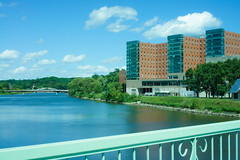Buffalo, N.Y. Hotel Proposal Controversy
Recent Developments
- “Old deeds threaten Buffalo, NY hotel development” — Wikinews, November 21, 2006
- “Proposal for Buffalo, N.Y. hotel reportedly dead: parcels for sale “by owner”” — Wikinews, November 16, 2006
- “Contract to buy properties on site of Buffalo, N.Y. hotel proposal extended” — Wikinews, October 2, 2006
- “Court date “as needed” for lawsuit against Buffalo, N.Y. hotel proposal” — Wikinews, August 14, 2006
- “Preliminary hearing for lawsuit against Buffalo, N.Y. hotel proposal rescheduled” — Wikinews, July 26, 2006
- “Elmwood Village Hotel proposal in Buffalo, N.Y. withdrawn” — Wikinews, July 13, 2006
- “Preliminary hearing against Buffalo, N.Y. hotel proposal delayed” — Wikinews, June 2, 2006
Original Story
- “Hotel development proposal could displace Buffalo, NY business owners” — Wikinews, February 17, 2006
Saturday, March 4, 2006
Buffalo, New York —The Common Council requested on Tuesday that a picture be found on what many thought was the site of a previous hotel.
The Proposed Elmwood Village Hotel would be placed on the intersection of Elmwood and Forest. It was suspected by residents and business owners in the area that hotel once stood in the same spot.
The Elmwood Village hotel is a proposed development by Savarino Construction Services Corp. In order for the project to proceed, at least five buildings (1119-1121 Elmwood) would need to be demolished. All five houses are currently occupied by businesses and residents.
After some research, a freelance journalist writing for Wikinews was able to determine that there was never a hotel on the proposed Elmwood Village Hotel site. However; there was a temporary hotel located on the northeast corner of Elmwood and Forest.
Buffalo was the host of the Pan-American Exposition from May 1 until November 2, 1901. It was a fair designed to feature the latest in technology, including electricity. There was a midway, athletic events, and had African, Eskimo, and Mexican villages. However; what is likely the most famous event that took place at the exposition was the assassination of then President William McKinley on September 6, 1901. He was shot by Leon Czolgosz just outside the Temple of Music and died eight days later while in the home of John Milburn on Delaware Avenue in Buffalo. Just a short time later, Theodore Roosevelt was inaugurated on September 14, 1901 at the Wilcox House on Delaware Avenue in Buffalo. Nearly eight million people attended the exposition.
During that time several hotels and rooming houses were built around the exposition including The Elmwood at 717 Elmwood, the Hotel Elmhurst at Forest and Lincoln Parkway, Hotel Gibbs 1005-1021 Elmwood, the R. Palmerton Merritt at 441 Forest and The Norman at 422 Forest. None of these hotels or rooming houses exist today.
Probably the most famous hotel that was built during the exposition was the Statler’s Pan-American Hotel built by Ellsworth Milton Statler A freelance journalist writing for Wikinews has obtained the only known reproduction photo of the hotel [pictured at the top]. The hotel stood on the northeast corner of Elmwood and Forest Avenues in Buffalo, had 2,100 sleeping rooms and accommodations for 5,000. At the time, the Statler was the largest hotel [based on the number of rooms] ever constructed. It was also the largest temporary hotel. It was three stories high, plastered on the inside, made mostly of wood and was covered with ornamental staff on the outside, which made it semi-fireproof. Every room was an outside room and was well lighted and ventilated. It was located within one block of the exposition’s main entrance.
The Statler was built for only one thing, the exposition. Work began in 1900 and finished just before the beginning of the exposition. When the exposition ended in November, the hotel was taken down.
Maps from 1894 show that there was no hotel, let alone any buildings or houses on the intersection. However; research did show that the homes 1119-1121 Elmwood, the buildings that would be demolished to build the Elmwood Village Hotel, were built sometime before 1915 but were not on the intersection prior to 1902.
Based on research conducted at the Buffalo Historical Society, it was concluded that between the years of 1890 and 1902, no other major hotel existed in the area. In fact, research had shown that almost every hotel built in the area, existed only during the time of the exposition.
Research also indicated a hotel or a rooming house at 1089 Elmwood around 1901-1903. The only known name of the hotel was the John C. Hill Hotel. The hotel was in the house now called the Atwater House. The house was the first house to be built on the east side of the block.
The Atwater House is currently vacant and owner Pano Georgiadis wants to demolish it to expand his restaurant. The house was built by 1894 and the original owner and builder of the house is currently unknown. Its earliest known occupant was Edward Atwater who in 1862 founded the oil refinery company of Atwater & Hawes in Buffalo. The site of this company was recently uncovered in the Canal District during an archeological dig.
At the moment, current research does not show any connection between the two men.
The exposition was a commercial failure and what profit Statler did make on the hotel, went to build another temporary hotel for the 1904 St. Louis Exhibition. That hotel was successful and the profit made from it was used to build the first permanent Statler Hotel at 107 Delaware Avenue in Buffalo. The hotel is no longer in operation, but small offices are currently operating in parts of the building.

